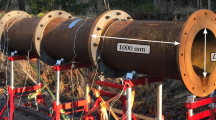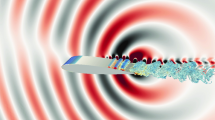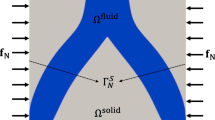Abstract
This work reviews theoretical–experimental studies undertaken at COPPE/UFRJ on conjugated heat transfer problems associated with the transient thermal behavior of heated aeronautical Pitot tubes and wing sections with anti-icing systems. One of the main objectives is to demonstrate the importance of accounting for the conduction–convection conjugation in more complex models that attempt to predict the thermal behavior of the anti-icing system under adverse atmospheric conditions. The experimental analysis includes flight tests validation of a Pitot tube thermal behavior with the military aircraft A4 Skyhawk (Brazilian Navy) and wind tunnel runs (INMETRO and NIDF/COPPE/UFRJ, both in Brazil), including the measurement of spatial and temporal variations of surface temperatures along the probe through infrared thermography. The theoretical analysis first involves the proposition of an improved lumped-differential model for heat conduction along a Pitot probe, approximating the radial temperature gradients within the metallic and ceramic (electrical insulator) walls. The convective heat transfer problem in the external fluid is solved using the boundary layer equations for compressible flow, applying the Illingsworth variables transformation considering a locally similar flow. The nonlinear partial differential equations are solved using the Generalized Integral Transform Technique in the Mathematica platform. In addition, a fully local differential conjugated problem model was proposed, including both the dynamic and thermal boundary layer equations for laminar, transitional, and turbulent flow, coupled to the heat conduction equation at the sensor or wing section walls. With the aid of a single-domain reformulation of the problem, which is rewritten as one set of equations for the whole spatial domain, through space variable physical properties and coefficients, the GITT is again invoked to provide hybrid numerical–analytical solutions to the velocity and temperature fields within both the fluid and solid regions. Then, a modified Messinger model is adopted to predict ice formation on either wing sections or Pitot tubes, which allows for critical comparisons between the simulation and the actual thermal response of the sensor or structure. Finally, an inverse heat transfer problem is formulated aimed at estimating the heat transfer coefficient at the leading edge of Pitot tubes, in order to detect ice accretion, and estimating the relative air speed in the lack of a reliable dynamic pressure reading. Due to the intrinsic dynamical behavior of the present inverse problem, it is solved within the Bayesian framework by using particle filter.





















Similar content being viewed by others
References
Luikov AV, Aleksashenko VA, Aleksashenko AA (1971) Analytical methods of solution of conjugated problems in convective heat transfer. Int J Heat Mass Transf 14:1047–1056
Luikov AV (1974) Conjugate convective heat transfer problems. Int J Heat Mass Transf 17(2):257–265
Perelman TL (1961) On conjugated problems of heat transfer. Int J Heat Mass Transf 3:293–303
Cotta RM (1990) Hybrid numerical-analytical approach to nonlinear diffusion problems. Num Heat Transf Part B 127:217–226
Cotta RM (1993) Integral transforms in computational heat and fluid flow. CRC Press, Boca Raton
Cotta RM, Mikhailov MD (1997) Heat conduction: lumped analysis, integral transforms, symbolic computation. Wiley-Interscience, Chichester
Cotta RM (1998) The integral transform method in thermal and fluids sciences and engineering. Begell House, New York
Cotta RM, Mikhailov MD (2006) Hybrid Methods and Symbolic Computations. In: Minkowycz WJ, Sparrow EM, Murthy JY (eds) Handbook of numerical heat transfer, 2nd edn, chap 16. Wiley, New York
Guedes ROC, Cotta RM, Brum NCL (1991) Heat transfer in laminar tube flow with wall axial conduction effects. J Thermophys Heat Transf 5(4):508–513
Guedes ROC, Cotta RM (1991) Periodic laminar forced convection within ducts including wall heat conduction effects. Int J Eng Sci 29(5):535–547
Naveira CP, Lachi M, Cotta RM, Padet J (2009) Hybrid formulation and solution for transient conjugated conduction–external convection. Int J Heat Mass Transf 52(1–2):112–123
Nunes JS, Cotta RM, Avelino MR, Kakaç S (2010) Conjugated heat transfer in microchannels. In: Kakaç S, Kosoy B, Pramuanjaroenkij A (eds) NATO science for peace and security series A: chemistry and biology, microfluidics based microsystems: fundamentals and applications. pp 61–82
Knupp DC, Naveira-Cotta CP, Cotta RM (2012) Theoretical analysis of conjugated heat transfer with a single domain formulation and integral transforms. Int Commun Heat Mass Transf 39(3):355–362
Knupp DC, Naveira-Cotta CP, Cotta RM (2013) Conjugated convection–conduction analysis in micro-channels with axial diffusion effects and a single domain formulation. ASME J Heat Transf (Special Issue on Micro/Nanoscale Heat and Mass Transfer) 135(9):091401–091411
Knupp DC, Cotta RM, Naveira-Cotta CP (2013) Heat transfer in microchannels with upstream-downstream regions coupling and wall conjugation effects. Num Heat Transf Part B Fundam 64:365–387
Knupp DC, Cotta RM, Naveira-Cotta CP, Kakaç S (2015) Transient conjugated heat transfer in microchannels: integral tranforms with single domain formulation. Int J Therm Sci 88:248–257
Knupp DC, Naveira-Cotta CP, Cotta RM (2014) Theoretical-experimental analysis of conjugated heat transfer in nanocomposite heat spreaders with multiple micro-channels. Int J Heat Mass Transf 74:306–318
Knupp DC, Cotta RM, Naveira-Cotta CP (2015) Fluid flow and conjugated heat transfer in arbitrarily shaped channels via single domain formulation and integral transforms. Int J Heat Mass Transf 82:479–489
Cotta RM, Quaresma JNN, Sphaier LA, Naveira-Cotta CP (2010) Unified integral transform approach in the hybrid solution of multidimensional nonlinear convection–diffusion problems. 14th International heat transfer conference, vol 2, paper no IHTC14-22396, pp 477–486, Washington, DC
Sphaier LA, Cotta RM, Naveira-Cotta CP, Quaresma JNN (2011) The UNIT algorithm for solving one-dimensional convection–diffusion problems via integral transforms. Int Commun Heat Mass Transf 38(5):565–571
Cotta RM, Knupp DC, Naveira-Cotta CP, Sphaier LA, Quaresma JNN (2013) Unified integral transforms algorithm for solving multidimensional nonlinear convection–diffusion problems. Num Heat Transf Part A Appl 63:1–27
Cotta RM, Knupp DC, Naveira-Cotta CP, Sphaier LA, Quaresma JNN (2014) The unified integral transforms (UNIT) algorithm with total and partial transformation. Comput Therm Sci 6(6):507–524
Wolfram S (2008) The Mathematica book. Wolfram Media, Cambridge
Gent RW, Dart NP, Cansdale JT (2000) Aircraft icing. Philos Trans R Soc Lond A 358:2873–2911
Caliskan F, Aykan R, Hajiyev C (2008) Aircraft icing detection, identification, and reconfigurable control based on kalman filtering and neural networks. J Aerosp Eng 21(2):51–60
Souza JRB, Zotin JLZ, Loureiro JBR, Naveira-Cotta, CP, Silva Freire AP, Cotta RM (2011) Conjugated heat transfer analysis of heated Pitot tubes: wind tunnel experiments, infrared thermography and lumped-differential modeling. 21st International congress of mechanical engineering, COBEM-2011, ABCM, Natal, October 2011
Lisboa KM, Souza JRB, Cotta RM, Naveira-Cotta CP (2012) Transient conjugated heat transfer in external compressible laminar flow over plates with internal heat generation. VII National congress of mechanical engineering, CONEM 2012, São Luis, pp 1–10, 31st July–3rd August, 2012
Souza JRB, Lisboa KM, Cerqueira IG, Naveira-Cotta CP, Cotta RM, Zotin JLZ (2012) Conjugated heat transfer models for heated aeronautical Pitot tubes: experimental validation with A4 Skyhawk flight tests. 14th Brazilian congress of thermal sciences and engineering, ENCIT 2012, Rio de Janeiro, November, 2012
Lisboa KM, Souza JRB, Cotta RM (2013) Thermal analysis of an aeronautical Pitot probe with anti-icing system: modeling, simulation and parametric studies. In: Proceedings of the 22nd international congress of mechanical engineering—COBEM 2013, Ribeirão Preto, November 3–7, 2013
Lisboa KM, Cotta RM (2014) External flow conjugated problem analysis via integral transforms and single domain formulation. 3rd International conference on computational methods for thermal problems—ThermaComp2014, Lake Bled, June, 2014
Allahyarzadeh AB, Souza JRB, Lisboa KM, Cotta RM (2015) Thermal analysis of heated Pitot probes in atmospheric conditions of ice accretion. In: Proceedings of the 23rd international congress of mechanical engineering—COBEM 2015, Rio de Janeiro, RJ, Brazil, December 6th–10th, 2015
Souza JRB, Lisboa KM, Cerqueira IG, Naveira-Cotta CP, Cotta RM, Zotin JLZ (2015) Conjugated heat transfer analysis of heated aeronautical Pitot probes with flight tests experimental validation. Heat Transf Eng 36:991–1000
Ozisik MN, Mikhailov MD (1984) Unified analysis and solutions of heat and mass diffusion. Wiley, New York
Cebeci T, Cousteix J (2005) Modeling and computation of boundary layer flows, 2nd edn. Springer, Berlin
Schlichting H, Truckenbrodt E (1979) Aerodynamics of the airplane, 1st edn. McGraw-Hill, New York
Myers TG (2001) Extension to the Messinger model for aircraft icing. AIAA J Am Inst Aeronaut Astronaut 39(2):211–218
Myers TG, Charpin JPF, Thompson CP (2002) Slowly accreting ice due to super cooled water impacting on a cold surface. Phys Fluids 14(1):240–256
Özgen S, Canibek M (2009) Ice accretion simulation on multi-element airfoils using extended Messinger model. Heat Mass Transf 45(3):305–322
Lisboa KM (2015) Model for ice formation over heated aeronautical surfaces: potential flow, differential boundary layer model and single domain formulation. MSc thesis, COPPE-UFRJ
West M (1993) Approximating posterior distributions by mixture. J R Statist Soc B 55:409–422
Pitt M, Shephard N (1999) Filtering via simulation: auxiliary particle filters. J Am Statist Assoc 94(446):590–599
Doucet A, Freitas N, Gordon N (2001) Sequential Monte Carlo methods in practice. Springer, New York
Arulampalam S, Maskell S, Gordon N, Clapp T (2001) A tutorial on particle filters for on-line non-linear/non-Gaussian Bayesian tracking, IEEE, 18 p
Kaipio J, Somersalo E (2004) Statistical and computational inverse problems, applied mathematical sciences. Springer, Berlin
Ristic B, Arulampalam S, Gordon N (2004) Beyond the Kalman filter—particle filter for tracking applications. Artech House, Norwood
Orlande HRB, Colaço MJ, Dulikravich G, Vianna F, Silva WB, Fonseca H, Fudym O (2012) State Estimation Problems In Heat Transfer. International Journal for Uncertainty Quantification 2(3):239–258
Andrade GJA, Orlande HRB, Cotta RM (2014) Use of particle filters to estimate relative air speed in a Pitot tube. ICCHMT international symposium on convective heat and mass transfer in sustainable energy, CONV-14, Kusadasi, Turkey, June 2014
Souza JRB (2014) Theoretical-experimental thermal analysis of aeronautical Pitot probes, wind tunnel experiments, in flight testing and basic design of UFRJ climatic wind tunnel. DSc thesis, COPPE-UFRJ
Bidgoli AA (2013) Thermal analysis of aeronautical Pitot tubes with ice formation. MSc thesis, COPPE-UFRJ
Silva GAL, Silvares OM, Zerbini EJGJ (2007) Numerical simulation of airfoil thermal anti-ice operation part 1: mathematical modeling. J Aircr 44(2):627–633
Stefanini LM, Silvares OM, Silva GAL, Zerbini EJGJ (2008) Boundary-layers integral analysis—airfoil icing, AIAA paper 2008-0474. Aerospace sciences meeting and exhibit, 46th, 2008, Reno, American Institute of Aeronautics and Astronautics, Reston
Kind R (2001) Ice accretion simulation evaluation test, North Atlantic Treaty Organization—Research and Technology Organisation—NATO-RTO. Technical report 038, 32 p
Stefanini LM (2009) Effect of the thermal boundary layer on the ice formation over aeronautical airfoils. MSc thesis, Universidade de São Paulo, USP, São Paulo
Silva GAL (2010) Similarity studies for air data probes new standard—AS5562. Coupled heat and mass transfer effects, SAE AC-9C Aircraft Icing Technology Committee meeting October 8th–10th 2010—Portland
Acknowledgments
The authors are indebted to the Brazilian Navy, for providing the Pitot tubes here employed and sponsoring the A4 flight tests. The financial support of FAPERJ is also deeply acknowledged, which allowed for the design and construction of the first climatic wind tunnel in Brazil. The technical collaboration and support of Dr. P.F.L. Heilbron, Prof. S.A. Sherif, Prof R. Breidenthal, Prof. Otavio M. Silvares (in memorian), Prof. Olivier Fudym, Prof. Manish Tiwari, and Dr. Luciano Stefanini, along the development of this project, are also gratefully reminded. Most especially, Prof. Silvares was an enthusiast supporter of this project, since its very beginning, but unfortunately left us just too early to see it is completion. We would also like to express our sincere gratitude for the very kind and honoring invitation by the Editor-in-chief of the JBSMSE, Prof. Francisco Ricardo Cunha, to participate in this special issue.
Author information
Authors and Affiliations
Corresponding author
Additional information
Technical Editor: Francis H.R. Franca.
This work is dedicated to the 228 victims of the AF447 flight and their families. This hard lesson will hopefully affect somehow technology development protocols, in a progressively more competitive world, reminding us all that there is no acceptable, sustainable, and safe technological development without a supporting extensive scientific analysis.
Rights and permissions
About this article
Cite this article
de Souza, J.R.B., Lisboa, K.M., Allahyarzadeh, A.B. et al. Thermal analysis of anti-icing systems in aeronautical velocity sensors and structures. J Braz. Soc. Mech. Sci. Eng. 38, 1489–1509 (2016). https://doi.org/10.1007/s40430-015-0449-7
Received:
Accepted:
Published:
Issue Date:
DOI: https://doi.org/10.1007/s40430-015-0449-7




